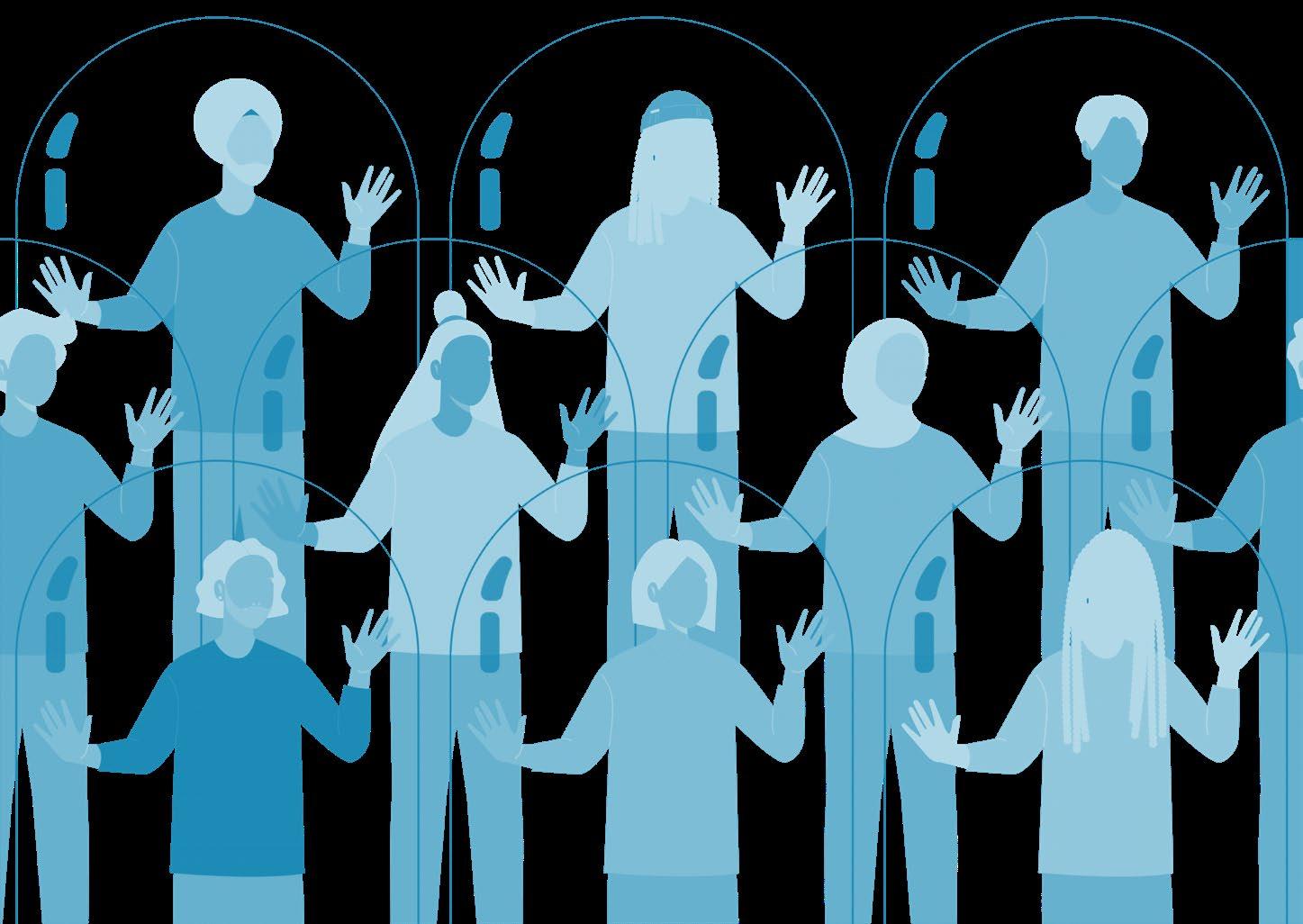

Accessibility ≠ Inclusion
Redefining Themed Entertainment Environments
Inclusive Design in Themed Entertainment
“The whole idea of going to a theme park is that you can escape the problems of your everyday life and instead play in a virtual reality in which those problems are washed away and replaced with a world of immersion, joy, ecstasy and excitement.” (Scott A. Lukas)

Theme parks are a unique architectural typology using multiple creative disciplines to envision a world that does not physically exist. They push the boundaries of design to develop places filled with magic. But for those with disabilities this isn’t always the case. When decision makers consider inclusion, they look to ADA building code or additive design solutions. Now, what kind of environment could we create that takes this idea a step further and truly includes people of all abilities without degrading the theatrical experience.
We must recognize that there is no one size fit all solution when it comes to theme parks, but there are steps one can take to provide a clearer direction for inclusive design. It all starts with bridging gaps and connecting people. It is not enough to just build spaces anymore, people need to feel welcomed.
Statistics
The World Health Organization estimates that 1.3 billion people globally—or 16% of the world’s population—have a significant disability. These include movement disorders, hearing and vision impairments, sensory processing issues, and cognitive conditions.
“Twenty five percent of the population (of the US) has some form of disability, so I don’t feel that finances or the size of the attraction are reasonable excuses to ignore the needs of a quarter of the population and, therefore, a quarter of potential customers.” (Allison Zuck – PGAV)
1.3 billion people
16% of the worlds population

A 2020 report by the Center for Disease Control (CDC), identified a near 10% rise in the number of ASD diagnoses between the 2014 and 2016 reporting years.
By 2030, 1 in 5 Americans will be 65 or older
60% of users benefit from accessible design even if they don’t identify as having a disability (WHO Forrester Research)
Disability is Institutional, Environmental, and Attitudinal
“Bio social perspectives note that impairment is usually collapsed into a series of general and chaotic categories, such as vision, mobility, and hardof-hearing, which do little to reveal the complexities of impairment. Indeed, impairment is neither fixed nor static, or confined to any particular part of the population. It can be temporary or permanent, debilitating or not; in short, it is a contingent condition dependent on circumstance... There is no single form of vision impairment nor, arguably, any singular building or design response which would or could cater for the multiplicity of needs of vision-impaired, or other, impaired people.” (Rob Imrie and Peter Hall)

Barriers of Inclusion
Attitudinal: May take the form of misconceptions, stereotypes, or labeling.
Administrative: result from a lack of leadership from boards of directors and administrators to recognize the need for inclusive environments and encourage more accepting organizations.
Architectural: the quality of the access provided by organizations.
Programmatic: The rules, regulations, and practices do not accurately serve the disabled community, and therefore may exclude people with limited abilities.
Improving ADA Building Code
The Department of Justice adopted the first ADA Standards for Accessible Design (“ADA Standards”), on July 26, 1991, known as the “1991 ADA Standards” and adopted revised ADA Standards on September 15, 2010, known as the “2010 ADA Standards”, along with the Guidance on the 2010 Standards.
The ADA Standards for Accessible Design (“ADA Standards”) cover:
• Newly constructed buildings and facilities;
• Alterations—such as, renovations and other changes that affect usability—made to buildings and facilities;
• Making architectural changes in existing state and local government buildings to provide “program access”; and
• Removing architectural barriers that are easily accomplishable without much difficulty or expense in existing buildings of businesses
It focuses on primarily individuals with mobility devices or with a visual impairment, ignoring almost half of the population with a disability. Architectural accessibility deals primarily with physical impairments, leading to accommodations such as ramps in addition to stairs, ADA compliant restroom stalls, or Braille writing on signage. This concept of accessibility does not adequately address all forms of disabilities.

ADA compliance is the bare minimum accommodation.
It can be difficult for designers to understand their audience:
• ADA doesn’t offer good guidance
• ADA uses subjective language
• ADA relies on the individual to make decisions on how to use the space
• Rules and limitations are general and unclear to guests
• Rules focus what disabilities you have and not what abilities you need may need
• Accessibility doesn’t just pertain to folks with a disability
While the Americans with Disabilities Act (ADA) set standards and building codes that help to ensure that designers and architects are accountable for the needs of individuals with physical disabilities, there is still more we can and must do.
Steps to Improvement
“There is also recognition that people’s needs are never static, and that design of buildings and other products ought to enhance, rather than inhibit, ‘the changing abilities of humans throughout their life-span.”
(Salmen and Ostroff 1997)
Don’t be afraid to have bold conversations
Educate
Start discussions early and create a roadmap of values and success
Understand your audience – Be intentional and seek global representation
Focus forward to reach renewal and redemption
Things are constantly changing so they need to be adaptable
The best creative ideas rely on connecting the unconnected
Eliminate reliance on single sensory experiences
Details to consider: Finishes, Lighting, Acoustics, Sensory zoning, Safety, Shade, Seating, Ground surface, Entrance and exit points. 1. Assessment/Gap

Empathy is the Foundation
Empathy is“a social and emotional skill that helps us feel and understand the emotions, circumstances, intentions and thoughts, and needs of others, such that we can offer sensitive, perceptive, and appropriate communication and support.” (Karla Mclaren)
Empathetic design pushes against the historical approaches of designing the built environment. Successful inclusive public spaces are driven by intersections of identity, culture, history, and memory. It results in a space that says, “We are here,” and equally, “We see you”.

“Empathetic Design” (Elgin Cleckley 2024)
Qualities of empathic designers:
Understand that the methods and approaches that create harmful designs can be retooled and rethought to produce designs that help support, and bring community together.
Develop approaches and methods that respectfully acknowledge often untold, marginalized narratives of the past, with goals of operating with care in the present, to create inclusive and equitable design futures.
Work co-creatively and facilitate spaces of trust in all stages of the design process, always honoring lived experience.
Redefine public spaces – working with nuances and meanings in materials. Reflect/Respect/Honor. Develop generational spaces for joy.
Work with care, bringing forth voices into form, changing ideological or dominant narratives in the built environment.
Constantly self-analyze to work with care, always open to change to meet the needs of the communities in which they collaborate.
Universal Design
Universal design is the design of products and environments to be usable by all people, to the greatest extent possible, without the need for adaptation or specialized design. – (Ronald Mace)
7 Principles
1. Equitable use: The design is useful and marketable to people with diverse abilities.
a. Provide the same means of use for all users: identical whenever possible; equivalent when not.
b. Avoid segregating or stigmatizing any users.
c. Provisions for privacy, security, and safety should be equally available to all users.
d. Make the design appealing to all users.
2. Flexibility in use: The design accommodates a wide range of individual preferences and abilities.
a. Provide choice in methods of use.
b. Accommodate right- or left-handed access and use.
c. Facilitate the user’s accuracy and precision.
d. Provide adaptability to the user’s pace.
3. Simple and intuitive: Use of the design is easy to understand, regardless of the user’s experience, knowledge, language skills, or current concentration level.
a. Eliminate unnecessary complexity.
b. Be consistent with user expectations and intuition.
c. Accommodate a wide range of literacy and language skills.
d. Arrange information consistent with its importance.
e. Provide effective prompting and feedback during and after task completion.
4.
Perceptible information: The design communicates necessary information effectively to the user, regardless of ambient conditions or the user’s sensory abilities.
a. Use different modes (pictorial, verbal, tactile) for redundant presentation of essential information.
b. Provide adequate contrast between essential information and its surroundings.
c. Maximize “legibility” of essential information.
d. Differentiate elements in ways that can be described.
e. Provide compatibility with a variety of techniques or devices used by people with sensory limitations.
5. Tolerance for error: The design minimizes hazards and the adverse consequences of accidental or unintended actions.
a. Arrange elements to minimize hazards and errors: most used elements, most accessible; hazardous elements eliminated, isolated, or shielded.
b. Provide warnings of hazards and errors.
c. Provide fail safe features.
d. Discourage unconscious action in tasks that require vigilance.
6.
7.
Low physical effort: The design can be used efficiently and comfortably and with a minimum of fatigue.
a. Allow user to maintain a neutral body position.
b. Use reasonable operating forces.
c. Minimize repetitive actions.
d. Minimize sustained physical effort.
Size and space for approach and use: Appropriate size and space is provided for approach, reach, manipulation, and use regardless of user’s body size, posture, or mobility.
a. Provide a clear line of sight to important elements for any seated or standing user.
b. Make reach to all components comfortable for any seated or standing user.
c. Accommodate variations in hand and grip size.
d. Provide adequate space for the use of assistive devices or personal assistance.
The 5 E’s: Defining a Guest’s Journey
Entice
How do we excite guests about their visit long before they arrive?
Enter
How do we create an entry experience, a ritual, that delivers on the promises made in your marketing?
Engagement
This is the heart of your guest’s experience – what do they see, feel, touch and do? What are the shows, exhibits, and experiences that will guarantee a connection with your fans that is emotional, physical, and intellectual?
Emotional Exit
How to we create an emotional exit experience that acknowledges your guests’ transformation and triggers a change in behavior and/or a desire to return?
Extend
What happens after the visit to reinforce your guests’ new passion for the venue, team or brand?
(BRC Imagination Arts)
Jenevieve Mota
ARCH 419
Fall 2024

